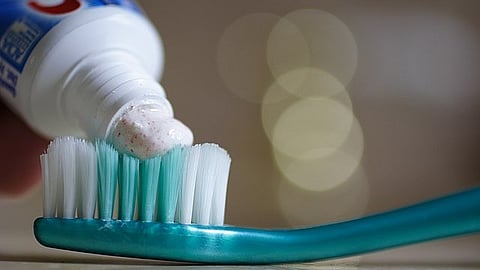

Introduction:
The debate between fluoride and fluoride-free toothpaste has become interesting in oral healthcare discussions. Toothpaste plays a crucial role in cleaning the teeth and also protecting the teeth from caries. Fluoride, a naturally occurring mineral found in the earth's crust, is emitted into the atmosphere, soil, and water. It is released into the air, soil, and water. Fluoride makes the teeth resistant to cavity-forming acids.
What does fluoride do?
Fluoride ions interact with the hydroxyapatite crystals in the enamel and form fluorapatite crystals. Fluoroapatite crystals strengthen the enamel and make it more resistant to acid attacks. Fluoride ions inhibit the demineralization of the enamel by interfering with the metabolic activity of the bacteria. Fluoride disrupts the enzymatic activity of the bacteria which reduces their ability to metabolize sugars and produce acids. Fluoride also induces the production of saliva which helps to wash away the food particles.
Fluoride toothpaste:
Fluoride toothpaste contains the following ingredients:
Fluoride: Fluoride is usually found in sodium fluoride, sodium monofluorophosphate, or stannous fluoride which makes the enamel resistant to acid attacks and prevents tooth decay.
Abrasives: Abrasive agents help remove plaque, stains, and food particles. Calcium carbonate, hydrated silica, and dicalcium phosphate are the common abrasives.
Surfactants: Sodium lauryl sulfate is the most commonly used surfactant. They help in the removal of debris and plaque. Surfactants create foam and disperse the toothpaste evenly in the mouth.
Flavoring agents: Mint, spearmint, peppermint, and various fruit flavors are the common flavoring agents used.
Humectants: Glycerin and sorbitol are the common humectants used to maintain the moisture in the toothpaste. These agents also give a smooth texture to the toothpaste.
Thickening agents: Cellulose gum, xanthan gum, and carrageenan are used as thickening agents to improve their desired consistency and texture.
Preservatives: Parabens and sodium benzoate are the common preservatives used to prevent microbial growth and ensure stability.
Sweeteners: Common sweeteners including sorbitol, saccharin, sorbitol, and xylitol are added to enhance their taste.
Additional ingredients: Whitening agents, desensitizing agents, anti-inflammatory agents, or herbal extracts are added.
Pros of Fluoride Toothpaste:
Prevention of tooth decay: Fluoride strengthens the tooth enamel and makes it resistant to acid attacks.
Remineralization of enamel: Fluoride promotes remineralization by encouraging the deposition of minerals like calcium and phosphate.
Fluorides protect the teeth from erosion caused by acidic foods, drinks, and plaque. Fluoride reduces the risk of enamel erosion, and tooth sensitivity by strengthening the enamel.
Reduction of plaque and gingivitis: Fluoride helps in the removal of plaque from teeth and gums. This reduces the incidence of gingivitis and protects the gum health.
Fluoride toothpaste reduces tooth sensitivity by strengthening tooth enamel
Safe and well-tolerated
Cons of Fluoride toothpaste:
Dental fluorosis: Overexposure to fluoride during the early stages of tooth development can cause dental fluorosis characterized by spots or streaks. Severe cases can result in pitting or discoloration of enamel.
Fluoride toxicity: Ingesting large amounts of fluoride can cause nausea, vomiting, abdominal pain, seizures, cardiac arrhythmias
Certain individuals may encounter allergic responses, such as oral irritation, itching, or swelling of the lips. Surfactants, flavoring agents, or preservatives can predispose to allergic reactions.
There can be environmental implications regarding the disposal of packaging and the release of chemicals during the manufacturing process
Fluoride resistance: Prolonged exposure to fluoride can lead to the development of fluoride-resistant strains of bacteria. Thus, there will be a reduction in the effectiveness of fluoride in preventing tooth decay.
Fluoride-free toothpaste:
Fluoride-free toothpaste does not contain fluorides as its active ingredient. These are used in the case of:
Fluoride allergy
Dental fluorosis
Children with a habit of swallowing toothpaste
Fluoride-free toothpaste contains the following ingredients:
Calcium carbonate or baking soda: These abrasives help in the removal of bacterial stains and plaque
Silica
Xylitol: Natural sweetener that prevents cavities by reducing the growth of bacteria.
Glycerin: Humectant that retains the moisture and texture in the toothpaste
Water: Acts as a base for the toothpaste
Pros of fluoride-free toothpaste:
Avoidance of fluoride overexposure
Individuals with fluorosis or thyroid disorders can opt for fluoride-free toothpaste.
These pastes contain natural ingredients such as essential oils, plant-based abrasives, and herbal extracts.
These pastes can be preferred in individuals who are sensitive to fluorides.
Fluoride-free toothpastes are considered safe for children who are prone to swallowing
Cons of fluoride-free toothpaste:
Reduced protection against caries
Limited effectiveness
Increased risk of cavities
Lack of scientific evidence
Higher cost
Conclusion:
In summary, the decision between fluoride and fluoride-free toothpaste hinges on personal preferences, specific concerns, and individual oral health requirements. Extensively studied and endorsed by dental experts, fluoride toothpaste stands as a scientifically validated solution for combating tooth decay and improving oral well-being. Its efficacy in fortifying tooth enamel and diminishing cavity risk is widely acknowledged, underlining its importance in daily oral care practices.
References:
1. "Fluorides – PubChem Public Chemical Database". The PubChem Project. USA: National Center for Biotechnology Information. Identification.
2. Derakhshani, R; Raoof, A; Mahvi, AH; Chatrouz, H (2020). "Similarities in the Fingerprints of Coal Mining Activities, High Ground Water Fluoride, and Dental Fluorosis in Zarand District, Kerman Province, Iran". Fluoride. 53 (2): 257–267.
3. Derakhshani, R; Tavallaie, M; Malek Mohammad, T; Abbasnejad, A; Haghdoost, A (2014). "Occurrence of fluoride in groundwater of Zarand region, Kerman province, Iran". Fluoride. 47 (2): 133–138.
